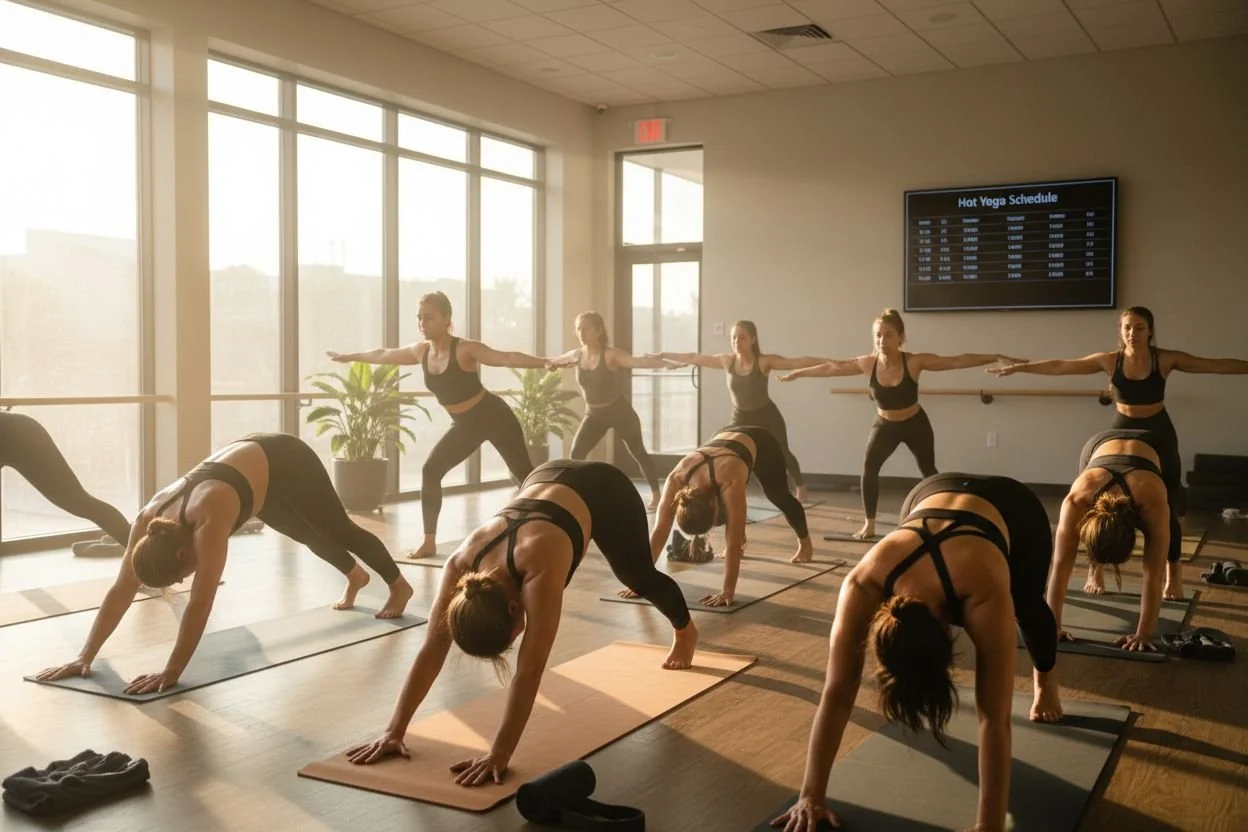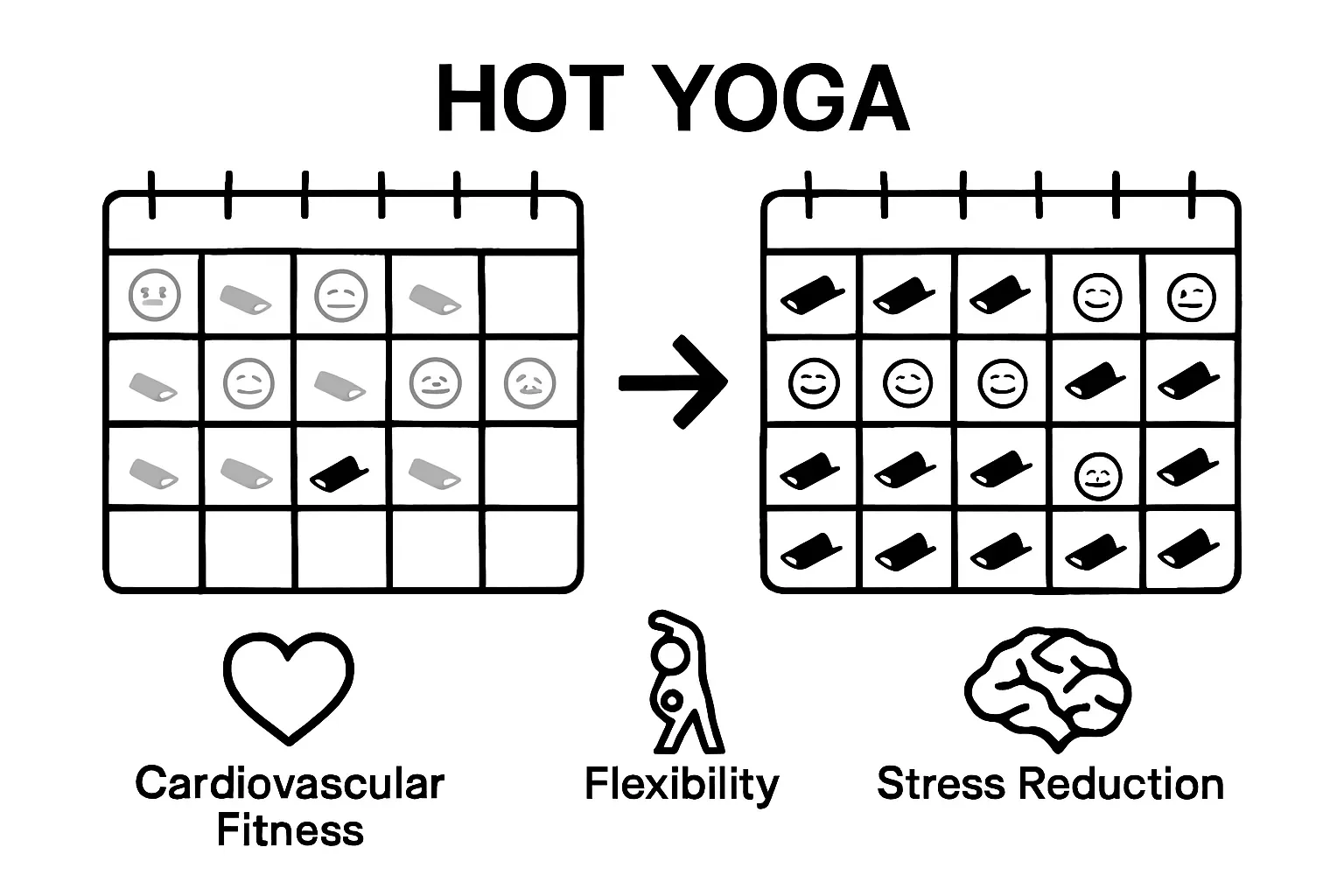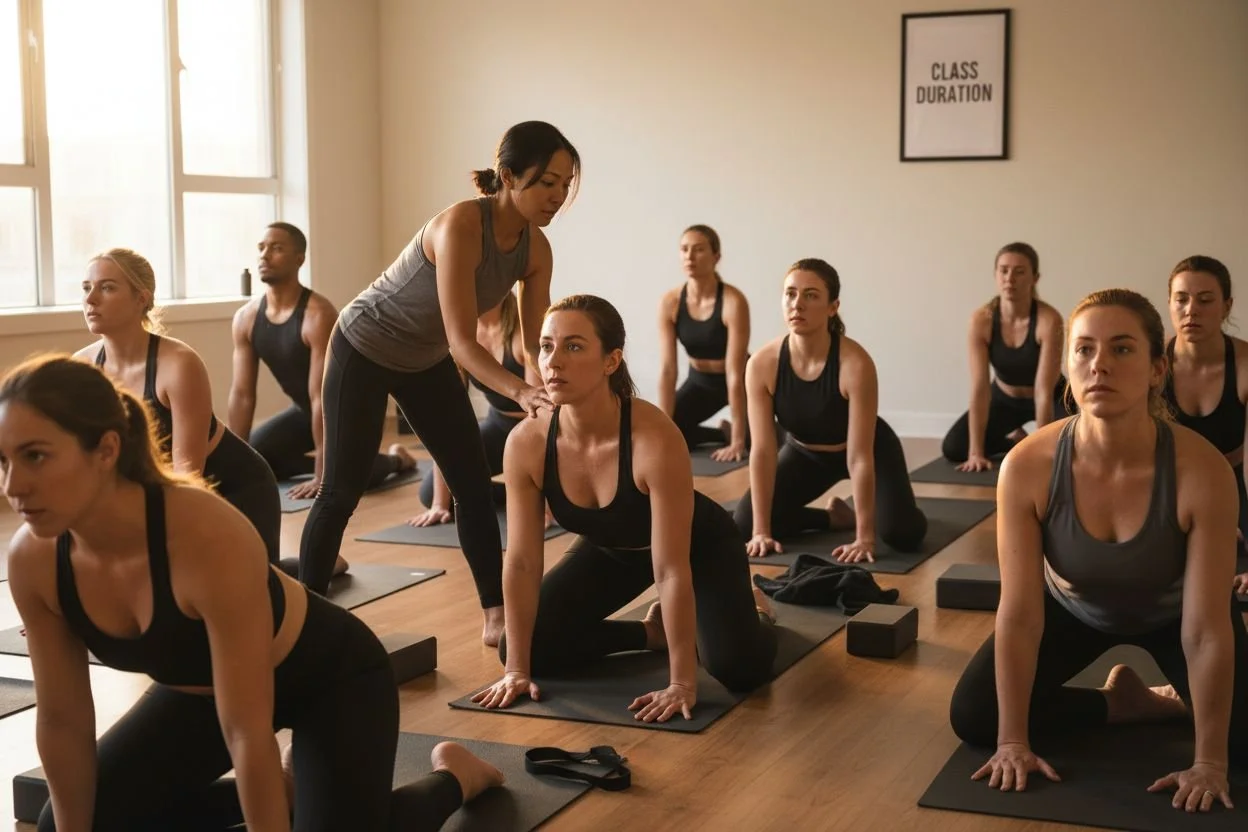Understanding Hot Yoga Schedule for Wellness and Balance
Heather Rice
Hot yoga is not just turning up the thermostat and calling it a workout. People step into rooms heated to as high as 105 degrees Fahrenheit just to hold their poses and work up a sweat. That might sound extreme at first but the real surprise is how this intense environment actually unlocks better flexibility, faster stress relief, and measurable heart health benefits for regular practitioners.
Table of Contents
Quick Summary
TakeawayExplanationHot yoga enhances physical and mental benefits.Practicing yoga in a heated environment promotes flexibility, strength, and mental resilience.Regular hot yoga sessions improve health.Consistent practice boosts cardiovascular endurance, metabolic efficiency, and overall joint mobility.Structured schedules optimize personal growth.A planned approach to hot yoga fosters routine, helping practitioners achieve sustained wellness in body and mind.Psychological resilience is strengthened through practice.Regular hot yoga serves as a form of moving meditation, aiding in stress reduction and emotional regulation.Class structure maximizes benefits.Classes are designed with specific sequences and timing to improve both physical performance and mental focus.
What is Hot Yoga and Its Origins?
Hot yoga represents a transformative wellness practice that combines traditional yoga principles with a carefully controlled environmental approach. At its core, hot yoga involves practicing yoga postures in a heated room, typically maintained between 90°F and 105°F, creating an intense physical and mental experience that challenges practitioners both internally and externally.
The Foundational Philosophy
Originally popularized by Bikram Choudhury in the 1970s, hot yoga emerged as a specialized yoga discipline designed to enhance physical flexibility, mental resilience, and overall bodily detoxification. Research from the National Institutes of Health suggests that practicing yoga in heated environments can significantly improve cardiovascular performance and metabolic function.
The fundamental philosophy behind hot yoga centers on several key principles:
Creating a controlled, intense environment that mimics the challenging conditions of traditional yoga practices
Promoting deep muscular engagement through heat-induced flexibility
Encouraging mental focus and discipline through physical challenge
Modern Interpretations and Variations
While Bikram yoga remains the most recognized form of hot yoga, contemporary studios have developed numerous variations that adapt the core concept. These modern interpretations maintain the heated environment but offer more diverse sequences and approaches. Learn more about our hot yoga studio experience to understand how different styles can complement individual wellness goals.
Modern hot yoga practices often emphasize:
Personalized modifications for different fitness levels
Integration of mindfulness and breathwork techniques
Holistic approach to physical and mental well-being
Understanding hot yoga requires recognizing it as more than just a physical workout. It represents a comprehensive approach to health that challenges practitioners to develop strength, flexibility, and mental resilience through a uniquely controlled and intense practice.
Why a Hot Yoga Schedule is Important for Practitioners
Establishing a consistent hot yoga practice transcends mere physical exercise and becomes a strategic approach to holistic wellness. A structured hot yoga schedule transforms sporadic workouts into a deliberate pathway for personal transformation, offering practitioners comprehensive benefits that extend far beyond traditional fitness routines.
Physiological Benefits of Consistent Practice
Research from the National Institutes of Healthdemonstrates that regular hot yoga practice contributes significantly to physiological adaptations. By committing to a consistent schedule, practitioners experience cumulative improvements in:
Cardiovascular endurance
Muscular strength and flexibility
Metabolic efficiency
Core body temperature regulation
These physiological enhancements occur through repeated exposure to controlled heat and intentional movement, which gradually train the body to become more resilient and efficient.
The predictability of a structured schedule allows the body to progressively adapt and optimize its performance.
Mental Wellness and Psychological Resilience
Beyond physical benefits, a disciplined hot yoga schedule cultivates profound psychological advantages. Regular practice becomes a form of moving meditation, providing practitioners a consistent space for mental recalibration. Learn more about our yoga studio experience to understand how structured practice impacts mental well-being.
The psychological benefits of a consistent hot yoga schedule include:
Stress reduction and emotional regulation
Enhanced mindfulness and present-moment awareness
Improved mental clarity and focus
Development of emotional resilience
A predictable hot yoga schedule creates a reliable framework for personal growth, transforming yoga from a sporadic activity into a sustainable lifestyle practice. By integrating regular sessions into one's routine, practitioners cultivate a powerful tool for comprehensive wellness that nurtures both body and mind.
To help practitioners understand the cumulative wellness benefits of a regular hot yoga schedule, the table below summarizes the key physical and psychological improvements discussed in the article.
CategoryBenefitDescriptionPhysicalStrength and FlexibilityEnhanced muscle tone, improved range of motionPhysicalCardiovascular EnduranceBoosted heart and lung capacityPhysicalMetabolic EfficiencyMore efficient calorie burning and energy usePhysicalJoint Mobility and Injury PreventionIncreased joint movement and reduced injury riskPsychologicalStress ReductionLower chronic stress and quicker mental recoveryPsychologicalEmotional RegulationImproved control over emotions and reactionsPsychologicalMental Clarity and FocusSharper attention and better decision-makingPsychologicalMindfulness and ResilienceHeightened present-moment awareness and adaptability
How Hot Yoga Classes are Structured and Timed
Hot yoga classes represent a meticulously designed wellness experience that combines precise environmental control, strategic sequencing, and intentional timing to maximize physical and mental benefits. Understanding the structure of these classes reveals the sophisticated approach behind this transformative practice.
Class Duration and Temperature Dynamics
Research from Sports Medicineindicates that hot yoga classes typically range between 60 to 90 minutes, with room temperatures maintained between 90°F and 105°F. These carefully calibrated parameters are not arbitrary but scientifically calculated to optimize physiological responses.
Key structural elements of hot yoga classes include:
Consistent room temperature control
Predetermined sequence of poses
Specific time allocations for different practice stages
Intentional rest and recovery intervals
Pose Sequencing and Flow Principles
Hot yoga classes follow a strategic progression designed to systematically warm muscles, enhance flexibility, and challenge practitioners both physically and mentally. Learn more about our fitness yoga studio experience to understand the nuanced approach to class design.
Typical hot yoga class segments generally include:
Initial breathing and centering (5-10 minutes)
Warm-up and initial pose sequences
Peak intensity and challenging pose series
Cool-down and final relaxation phase
The deliberate timing and sequencing ensure practitioners experience a comprehensive workout that balances intensity with mindful movement.
To clarify the structure and flow of a typical hot yoga class, the following table outlines the main class segments, their purposes, and approximate duration.
Class SegmentPurposeApproximate DurationBreathing and CenteringPrepare mind and body for practice5-10 minutesWarm-up PosesGently increase body temperature, flexibility10-15 minutesPeak Intensity PosesChallenge strength, balance, and endurance20-35 minutesCool-down and RelaxationAid recovery and promote mindfulness10-15 minutesFinal Rest (Savasana)Deep relaxation and integration5-10 minutes
Each segment serves a specific physiological and psychological purpose, transforming the class from a simple exercise routine into a holistic wellness practice.
Key Concepts Behind Hot Yoga and Scheduling
Hot yoga scheduling represents a sophisticated approach to wellness that integrates scientific principles of human physiology, psychological readiness, and intentional practice design. Understanding the underlying concepts provides practitioners with a comprehensive framework for developing an effective and transformative yoga practice.
Physiological Adaptation and Strategic Scheduling
Research from the National Institutes of Health highlights the critical importance of structured scheduling in hot yoga, demonstrating how systematic exposure to heated environments enables practitioners to develop physiological resilience and enhanced performance capabilities.
Key physiological adaptation principles include:
Gradual heat acclimatization
Progressive muscular conditioning
Cardiovascular system optimization
Metabolic efficiency development
Psychological and Energetic Considerations
Beyond physical requirements, hot yoga scheduling incorporates nuanced psychological and energetic dimensions. The timing and frequency of practice play crucial roles in mental preparation, stress management, and holistic wellness. Learn more about our comprehensive yoga experience to understand the deeper aspects of practice design.
Critical psychological scheduling considerations encompass:
Consistent practice rhythm
Mental preparation and intention setting
Balancing intensity with recovery
Personal energy cycle alignment
Effective hot yoga scheduling transforms practice from a simple exercise routine into a deliberate pathway of personal growth, integrating scientific understanding with mindful, intentional movement. By recognizing the sophisticated interplay between physiological adaptation and psychological readiness, practitioners can craft a truly transformative wellness journey.
Real-World Benefits of Following a Hot Yoga Schedule
A consistent hot yoga schedule transforms theoretical wellness concepts into tangible, measurable life improvements. By committing to regular practice, individuals unlock a comprehensive approach to physical, mental, and emotional well-being that extends far beyond traditional exercise routines.
Physical Health Transformation
Research from the National Institutes of Healthreveals that practitioners following a structured hot yoga schedule experience significant physiological enhancements. These benefits manifest through consistent, intentional practice that challenges and adapts the body's systems.
Key physical health benefits include:
Enhanced muscular strength and flexibility
Improved cardiovascular endurance
Advanced metabolic efficiency
Increased joint mobility and reduced injury risk
Mental Wellness and Stress Management
Beyond physical attributes, a disciplined hot yoga practice cultivates profound psychological resilience. The regularity of practice creates a predictable sanctuary for mental recalibration and emotional processing. Learn more about our comprehensive yoga experience to explore the deeper dimensions of wellness.
Psychological advantages of a consistent schedule encompass:
Reduced chronic stress levels
Enhanced emotional regulation
Improved mental clarity and focus
Development of mindfulness skills
A strategic hot yoga schedule represents more than a fitness routine. It is a holistic approach to personal development, offering practitioners a powerful framework for continuous physical, mental, and emotional growth. By integrating regular practice into one's lifestyle, individuals create a sustainable pathway to comprehensive wellness that adapts and evolves with their personal journey.
Unlock Your Ideal Hot Yoga Schedule for Real Wellness Results
Are you searching for lasting wellness and balance but struggling to stick to a consistent hot yoga routine? Many find it tough to build a practice that feels both achievable and truly transformative. Our recent guide has explored how a structured hot yoga schedule boosts strength, reduces stress, and creates real mental clarity. Now you can put these powerful ideas into action—right here in Philadelphia—at Amrita Yoga & Wellness.
Experience the benefits for yourself. Access live class scheduling, find class descriptions ideal for your goals, and connect with a supportive community of beginners and experts alike. Your pathway to flexibility, resilience, and full-body wellness starts when you choose your first class. Ready to begin? Visit our home page and explore our range of hot yoga classes and workshops, then join us for a personalized journey that helps your mind and body thrive.
Frequently Asked Questions
What is hot yoga?
Hot yoga involves practicing yoga postures in a heated room, typically between 90°F and 105°F. It combines traditional yoga principles with a heated environment to enhance flexibility, endurance, and mental resilience.
Why is a consistent hot yoga schedule important?
A consistent hot yoga schedule helps to establish a routine that promotes physical transformation, mental clarity, and stress management. Regular practice leads to cumulative improvements in cardiovascular endurance, muscular strength, and psychological well-being.
How long do hot yoga classes typically last?
Hot yoga classes usually last between 60 to 90 minutes. This duration is designed to maximize the physiological and mental benefits of the practice, with specific time allocations for warming up, peak intensity, and cool-down.
How can I balance intensity and recovery in my hot yoga schedule?
Balancing intensity and recovery involves syncing your practice with your personal energy cycles, incorporating intentional rest periods, and gradually increasing the challenge level in your sessions to ensure a sustainable and effective yoga experience.



